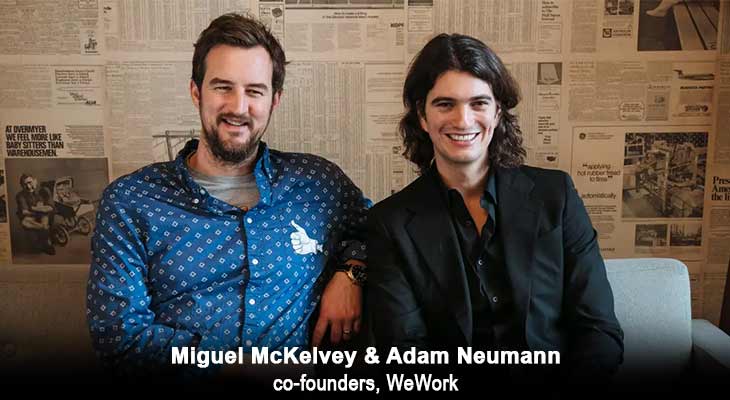From Glory to Bankruptcy: Unraveling the WeWork Saga
- ByStartupStory | November 13, 2023

In the not-so-distant past, WeWork was the shining star of the startup world, a revolutionary force in the office space industry valued at an astronomical $47 billion. However, the meteoric rise was soon followed by a dramatic fall, culminating in WeWork seeking U.S. bankruptcy protection. This blog will delve into the various facets that contributed to WeWork’s downfall, examining its ambitious business model, the eccentricities of its founder Adam Neumann, and the seismic impact of the COVID-19 pandemic on the company’s fortunes.
WeWork’s Ambitious Business Model
WeWork’s inception in 2010 marked a paradigm shift in the office market. The company aimed to disrupt the traditional real estate model by securing long leases on expansive properties and subletting the space to smaller businesses on more flexible, short-term arrangements. This approach initially led to rapid revenue growth but came at the cost of steep losses. Steve Clayton, head of equity funds at Hargreaves Lansdown, points out, “The company was the product of a boom, and during booms, investors ignore the flashing warning lights.”
The Founders
Founded by Adam Neumann, his wife Rebekah Neumann, and Miguel McKelvey, WeWork’s brand became synonymous with the flamboyant and freewheeling style of its Israel-born CEO. WeWork soared to become the most valuable U.S. startup, captivating investments from major players like SoftBank, Benchmark, and JPMorgan Chase. However, the pursuit of rapid growth at the expense of profits, coupled with revelations about Neumann’s eccentric behavior, led to his ouster and the derailment of an initial public offering in 2019.
Just before WeWork filed for bankruptcy this week, Neumann said, “I believe that, with the right strategy and team, a reorganization will enable WeWork to emerge successfully,” reflecting the founder’s optimism despite the impending financial storm.
The Spectacular IPO Implosion of 2019
WeWork’s first attempt at an initial public offering in 2019 turned into a spectacular failure. Investors raised concerns about the company’s substantial losses, questioning Neumann’s management style and corporate governance lapses. Estimates of WeWork’s value plummeted to $10 billion by 2021, a fraction of its former glory. The company eventually went public in October 2021 through a merger with a blank-check acquisition company, but the damage had been done.
The rise and fall of WeWork became fodder for a television series, “WeCrashed,” with Oscar winners Jared Leto and Anne Hathaway portraying the central figures of Adam and Rebekah Neumann.
The Impact of the COVID-19 Pandemic
WeWork’s troubles were exacerbated by the onset of the COVID-19 pandemic. As the world adapted to remote work, demand for office space plummeted, leading to corporate clients canceling agreements and the company grappling with expensive leases. Despite efforts to amend leases and restructure debts, WeWork found itself ensnared in a financial quagmire.
“Innovative financial metrics are rarely truly innovative, instead being a way of disguising a lack of cash profits, and WeWork played that game for all it was worth,” remarks Steve Clayton, highlighting the company’s strategic missteps.
Bankruptcy Protection
WeWork’s financial struggles reached a tipping point, compelling the company to seek U.S. bankruptcy protection. With long-term lease obligations totaling a staggering $13.3 billion as of June, the burden became insurmountable in the face of the post-COVID plunge in demand for office space. WeWork’s bankruptcy filing aimed at addressing its financial woes by converting secured debt into equity under a restructuring support agreement, effectively wiping out $3 billion of debt.
“WeWork could use provisions of the U.S. bankruptcy code to rid itself of onerous leases,” suggests law firm Cadwalader, Wickersham & Taft LLP, offering a potential lifeline for the beleaguered company.
What Lies Ahead for WeWork?
As WeWork navigates the treacherous waters of bankruptcy, the company announced that about 92% of its lenders had agreed to the conversion of secured debt into equity. This move is a crucial step in the restructuring process, indicating a collective effort to salvage the remnants of the once-mighty WeWork.
“I would not be surprised if SoftBank is simply trying to get as much of its own investment out of the company before it joins Titanic at the bottom,” speculates Sam Stovall, chief investment strategist of CFRA Research, highlighting the potential motivations of major stakeholders.
The Ripple Effect on the Commercial Property Market
The fall of WeWork reverberates beyond the confines of the company itself. The global commercial property lending market is predicted to face a challenging 2024, with vacancies expected to climb amid weak demand and investor reluctance to invest. The overall drop in real estate values serves as a testament to the profound impact of WeWork’s unraveling on the broader real estate landscape.
WeWork’s journey from the pinnacle of success to seeking bankruptcy protection is a cautionary tale of unchecked ambition, strategic missteps, and the unforeseen challenges posed by a global pandemic. The once-revolutionary workspace provider’s rise and fall serve as a stark reminder that even the most innovative business models can crumble under the weight of financial mismanagement and external disruptions. As WeWork charts its course through bankruptcy proceedings, the commercial property market braces for the aftershocks, underscoring the interconnectedness of ambitious startups and the broader economic landscape.








